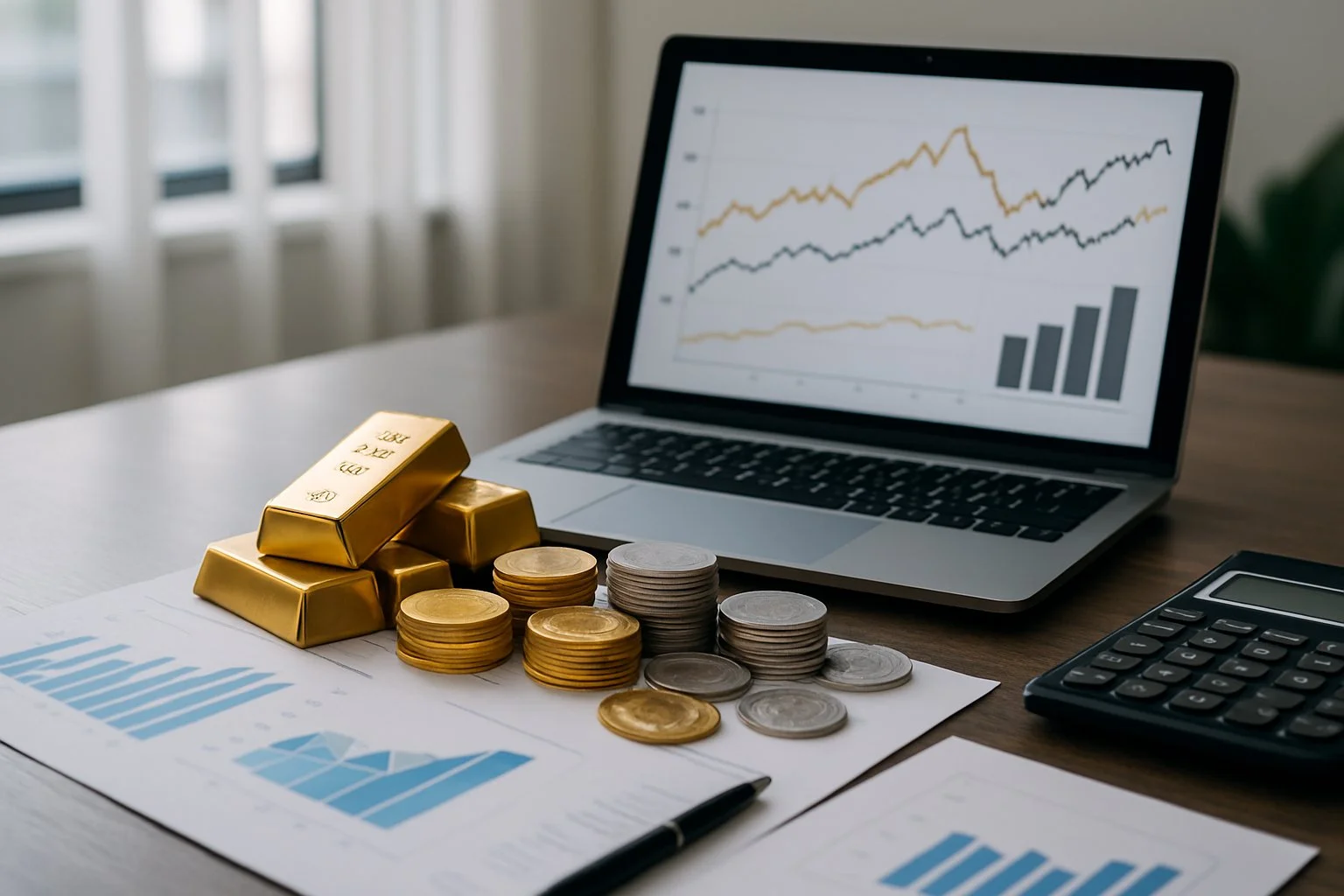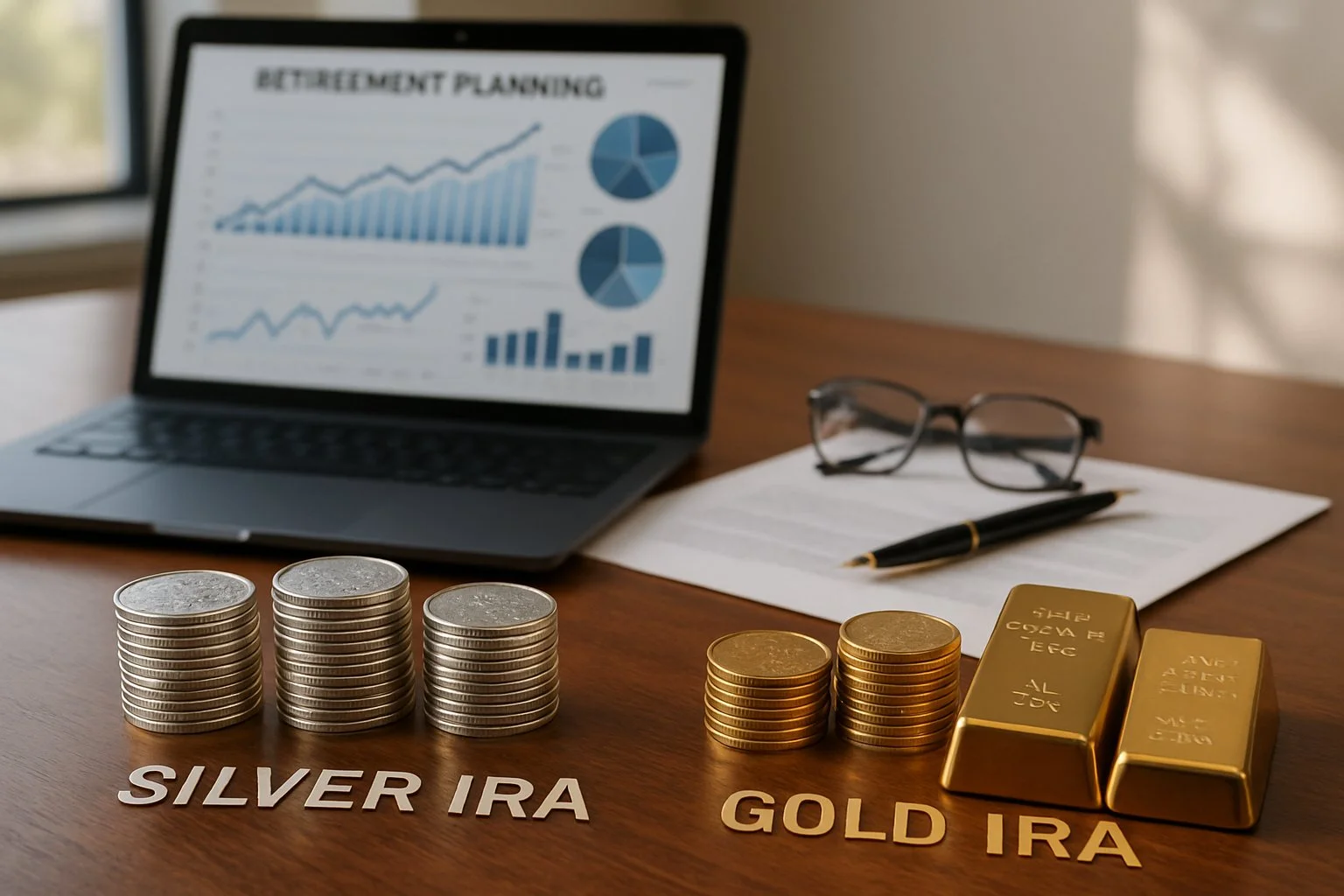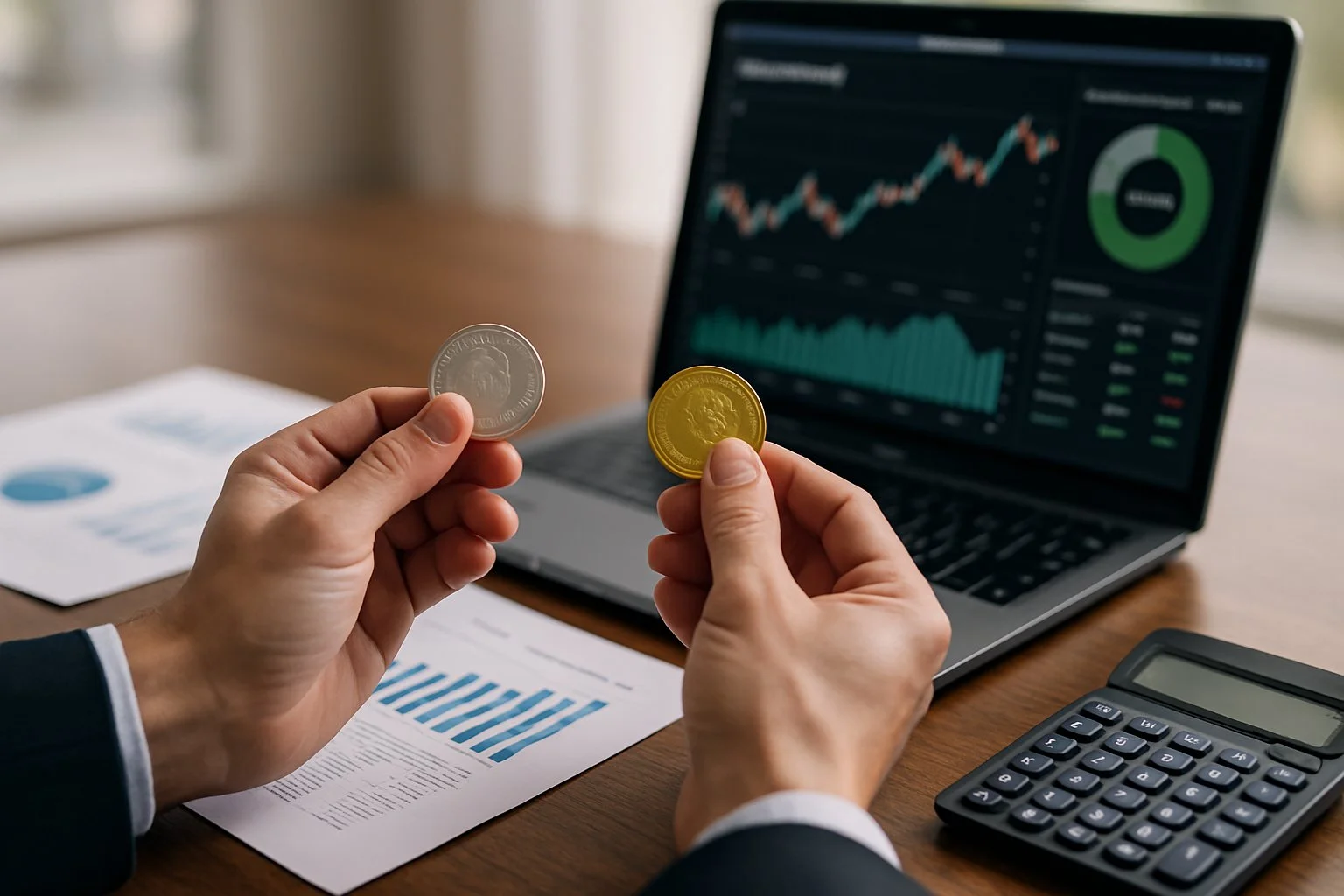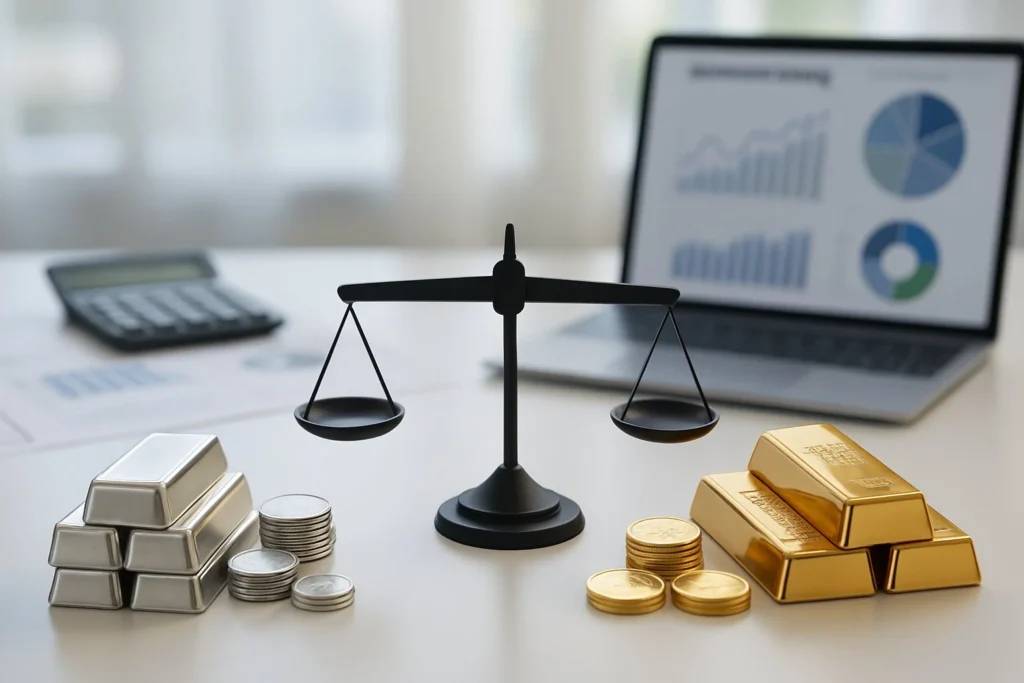Choosing between a Gold IRA and a Silver IRA can shape how well a retirement portfolio handles market changes. Both metals offer stability and diversification, but they behave differently in the market. Gold generally provides more long-term stability, while silver can offer higher growth potential during certain economic conditions.
Each option comes with unique benefits and risks. Gold tends to hold its value during economic downturns, making it a reliable hedge against inflation.
Silver often has more price swings, which can create both greater opportunities and greater risks.
Key Takeaways
- Gold offers more stability, while silver can have greater growth potential
- Each metal carries its own risks and benefits for retirement planning
- A balanced approach can provide both security and opportunity
Understanding Gold and Silver IRAs

Gold and silver can be held in certain Individual Retirement Accounts when set up as self-directed accounts. These accounts allow investors to own physical precious metals under specific IRS rules while keeping the same tax advantages as traditional IRAs.
What Is a Precious Metals IRA?
A Precious Metals IRA is a type of self-directed IRA that allows ownership of physical gold, silver, platinum, or palladium. Instead of holding only stocks, bonds, or mutual funds, the account holds approved bullion or coins.
The metals must meet IRS fineness standards. For example, gold must be at least 99.5% pure, and silver must be at least 99.9% pure.
The account is opened through a custodian that specializes in self-directed IRAs. The custodian handles storage arrangements with an IRS-approved depository.
Investors cannot store the metals at home. They must remain in secure, insured facilities to maintain the account’s tax-advantaged status.
Gold IRA vs. Silver IRA: Key Differences
A Gold IRA holds physical gold, while a Silver IRA holds physical silver. Both are forms of precious metals IRAs, but they differ in price stability, market demand, and storage costs.
Gold often has lower price swings and is widely used as a store of value. Silver prices can be more volatile but may offer greater percentage growth during certain market cycles.
Comparison Table:
| Feature | Gold IRA | Silver IRA |
|---|---|---|
| Typical Volatility | Lower | Higher |
| Industrial Demand | Limited | High (electronics, solar) |
| Storage Space Needed | Less per value stored | More per value stored |
| Historical Role | Wealth preservation | Growth potential + hedge |
Eligibility and IRS Requirements
Anyone eligible for a traditional or Roth IRA can open a precious metals IRA. Annual contribution limits are the same as for other IRAs, and age-based catch-up contributions apply.
The IRS requires that metals be held in the form of approved bullion bars or coins. Collectible coins generally do not qualify.
Transactions must go through an approved custodian. The custodian arranges purchase, shipping, and storage.
The investor cannot take direct possession without triggering a taxable distribution. Withdrawals follow the same rules as other IRAs, including early withdrawal penalties before age 59½ unless an exception applies.
Benefits and Risks of Gold IRAs

A Gold IRA allows investors to hold physical gold, such as American Gold Eagle coins, within a tax-advantaged retirement account. Gold can help protect retirement savings from currency fluctuations, market volatility, and long-term economic uncertainty.
However, it also comes with unique costs and risks that must be considered.
Stability and Wealth Preservation
Gold has a long history as a store of value. Unlike paper currency, it is not directly affected by inflationary monetary policies.
This makes it appealing for those seeking long-term stability in their retirement savings. In a Gold IRA, the asset is held in physical form, often in secure, insured storage.
This tangible ownership can provide reassurance during periods of market instability. However, gold does not generate income like dividends or interest.
Its value depends on market demand, which can fluctuate over time. Investors must weigh the stability benefits against the possibility of price stagnation or decline.
Protection Against Inflation
Gold is often viewed as a hedge against inflation because its value tends to move independently of paper currencies. When the cost of goods and services rises, gold prices may increase as investors seek assets that hold purchasing power.
A Gold IRA can help preserve real value in retirement savings during periods of high inflation. For example, during the 1970s inflation surge, gold prices rose significantly.
Still, there is no guarantee gold will always rise during inflationary periods. Short-term price movements can be unpredictable, and storage and custodian fees can reduce net returns.
Careful allocation is important to balance inflation protection with other investment goals.
Performance During Economic Downturns
Gold often performs well during economic downturns when confidence in stocks and bonds weakens. In times of financial crisis or geopolitical tension, demand for gold as a safe asset tends to increase.
A Gold IRA can help reduce portfolio losses during recessions by providing an asset class that is less correlated with equities. This diversification can be valuable for long-term investors.
However, gold prices can also drop if investors liquidate holdings to cover losses elsewhere. While gold may offer protection in many downturns, it is not immune to market pressure.
Benefits and Risks of Silver IRAs

Silver IRAs give investors exposure to a tangible asset that serves both as a store of value and as a material used in many industries. Silver’s price can be influenced by economic conditions, manufacturing trends, and investor demand, which makes it different from other retirement savings assets.
Industrial Demand and Growth Potential
Silver has a unique position in the market because it is used in both investment and industrial applications. It plays a role in electronics, solar panels, medical devices, and water purification systems.
These uses create consistent industrial demand. Rising adoption of renewable energy technology, especially solar power, can increase silver consumption over time.
This demand can support price growth, though it is not guaranteed. Compared to gold, silver’s price often reacts more strongly to changes in industrial production.
This means it can benefit when manufacturing activity is high. However, if industrial demand slows, prices can weaken.
Investors may view silver as having greater growth potential than gold in certain periods due to its broader market uses. This potential, however, comes with more price movement and less stability.
Affordability and Accessibility
Silver is more affordable per ounce than gold, making it easier for investors to purchase larger quantities for a Silver IRA. This lower entry cost can be appealing to those building retirement savings gradually.
Because of its lower price, investors can diversify holdings more easily within their IRA. They can spread purchases over time without committing large sums at once.
Physical silver is widely available through dealers and IRA custodians. This accessibility makes it simpler for investors to add it to their retirement accounts without complex arrangements.
While storage and insurance costs apply, these are typically lower in proportion to the value of the holdings compared to gold. This can help keep long-term investment expenses manageable.
Volatility and Market Trends
Silver prices tend to be more volatile than gold. The market can experience sharp swings due to changes in industrial demand, investor sentiment, and economic data.
During periods of economic growth, silver may outperform gold because of higher industrial use. In downturns, demand can fall quickly, leading to price drops.
Market trends in silver are also influenced by supply factors, such as mining output and recycling rates. Unexpected changes in production can push prices up or down.
For retirement savings, this volatility can be both a risk and an opportunity. Investors must be prepared for short-term price changes while focusing on long-term investment goals.
Comparing Gold and Silver IRAs

Gold and silver each play a distinct role in a retirement portfolio. Their differences in market behavior, resale value, and handling requirements can influence how well they fit an investor’s goals.
Diversification Benefits
Gold IRAs often provide stability during economic downturns because gold tends to hold value when other asset classes decline.
It has a long history as a store of wealth and is less volatile than many commodities.
Silver IRAs can add growth potential due to silver’s wider industrial use.
Demand from electronics, solar panels, and other sectors can create price movement that differs from gold.
This can help balance a portfolio when combined with other assets.
A precious metals IRA that includes both gold and silver can spread risk across two metals with different price drivers.
This approach may reduce reliance on a single market trend.
Investors can adjust the ratio based on their risk tolerance and time horizon.
Liquidity and Resale Value
Gold generally has higher liquidity in global markets.
Dealers and buyers often prefer gold because it is widely recognized, easier to store in high value, and has a long-established resale network.
Silver is also liquid but can be less convenient to sell in large amounts.
Its lower price per ounce means higher volumes are needed to match the value of gold, which can increase shipping and handling steps.
The resale value of both metals depends on purity, form (coins, bars), and market conditions.
For example:
| Metal | Typical Premium Over Spot | Common IRA Forms |
|---|---|---|
| Gold | Lower percentage | 1 oz coins, bars |
| Silver | Higher percentage | 1 oz coins, bars |
Storage and Insurance Considerations
Gold requires less space for the same dollar value compared to silver.
This can lower storage costs in a precious metals IRA since depositories often charge based on volume or weight.
Silver’s bulkier nature means more storage space and potentially higher fees.
For example, $50,000 in silver weighs far more than $50,000 in gold.
Insurance costs for both metals depend on total value, but silver’s volume can affect handling and security logistics.
Investors should compare custodian fees and confirm that the IRA provider uses approved, insured storage facilities for compliance and protection.
Factors to Consider When Choosing Between Gold and Silver

The choice between gold and silver in a retirement account depends on how each metal aligns with a person’s financial needs, market expectations, and time horizon.
Prices for both metals respond differently to changes in the economy, which can affect long-term portfolio stability and growth potential.
Investment Goals and Risk Tolerance
An investor’s risk tolerance plays a major role in selecting between gold and silver.
Gold is often viewed as a lower-risk option because it tends to hold value during market volatility.
It is commonly chosen for preserving wealth rather than generating high returns.
Silver, while also a store of value, is more volatile.
Its price can swing more due to industrial demand and market speculation.
This can lead to higher potential gains but also greater losses.
For retirement planning, those seeking stability may allocate more toward gold.
Those aiming for growth and willing to accept fluctuations may include a larger share of silver.
A financial advisor can help set an allocation that matches both investment goals and comfort with risk.
Current Economic Climate
Gold often performs well during economic downturns, high inflation, or geopolitical tensions.
It is widely seen as a safe-haven asset when confidence in other markets declines.
Silver can also rise during uncertain times but is more closely tied to economic growth because of its industrial uses in electronics, solar panels, and medical equipment.
In strong economies, industrial demand can push silver prices higher.
Investors may adjust their mix of gold and silver based on current trends.
For example:
| Condition | Gold Tendency | Silver Tendency |
|---|---|---|
| Recession / Inflation | Holds or increases value | May rise but volatile |
| Economic Expansion | Stable or modest gains | Often stronger growth |
Monitoring market signals can help determine when to favor one metal over the other.
Retirement Timeline and Objectives
The retirement timeline influences how much risk an investor can take.
Those close to retirement often prioritize capital preservation, which makes gold a more suitable choice.
Its price movements are generally less sharp, helping protect savings.
Younger investors with decades before retirement may accept more volatility for the chance of higher returns.
In this case, silver could be used for a portion of the portfolio to capture potential growth during economic expansions.
Retirement goals also matter.
If the objective is steady value and protection from inflation, gold may dominate the allocation.
If the goal includes growth alongside stability, a balanced mix of gold and silver can be considered.
How to Add Precious Metals to Your Retirement Portfolio

Adding physical gold, silver, platinum, or palladium to a retirement account requires specific steps to meet IRS rules.
Investors must open the right type of account, work with an approved custodian, and select only eligible metals and products.
Self-Directed IRA Setup
A self-directed IRA allows investors to hold alternative assets, including precious metals, instead of only stocks, bonds, or mutual funds.
This type of individual retirement account can be either traditional or Roth, with the same tax rules as standard IRAs.
To start, the investor opens a self-directed IRA with a provider that offers precious metals options.
This account must be separate from a standard IRA if the current custodian does not allow alternative assets.
Funding can come from a rollover or transfer from another retirement account, such as a 401(k) or traditional IRA.
The process must follow IRS rollover rules to avoid taxes or penalties.
Choosing a Custodian
The IRS requires a qualified custodian to hold the metals in a precious metals IRA.
This custodian manages the account, handles transactions, and arranges secure storage in an approved depository.
Investors should compare custodians based on fees, storage options, and experience with gold IRAs and silver IRAs.
Some specialize in certain metals, while others offer a wider range, including platinum and palladium.
Reputable custodians provide clear reporting, insured storage, and compliance with IRS regulations.
They should also work with trusted dealers to source metals that meet eligibility standards.
IRS-Approved Metals and Products
The IRS only allows certain precious metals in a retirement account.
Gold must be at least 99.5% pure, silver 99.9%, platinum and palladium 99.95%.
Coins and bars must be produced by approved mints or refiners.
Examples of eligible products include:
- Gold: American Gold Eagle, Canadian Gold Maple Leaf
- Silver: American Silver Eagle, Canadian Silver Maple Leaf
- Platinum/Palladium: American Platinum Eagle, Canadian Palladium Maple Leaf
Collectible coins, rare coins, and jewelry are not allowed.
The metals must be stored in an approved depository, not at home, to maintain the account’s tax-advantaged status.
Combined Strategies: Balancing Gold and Silver in Retirement
Holding both gold and silver in a retirement portfolio can help spread risk and smooth returns over time.
Each metal reacts differently to market changes, which can make them complement each other in long-term wealth preservation.
Allocation Strategies
Investors often split their precious metals holdings between gold and silver based on goals and risk tolerance.
Gold tends to hold value during economic slowdowns, while silver can offer more growth potential during strong industrial demand.
A common approach is to allocate 60–80% to gold and 20–40% to silver.
This leans on gold’s stability while keeping exposure to silver’s potential price gains.
Some adjust allocations over time.
For example:
| Market Outlook | Gold Allocation | Silver Allocation |
|---|---|---|
| Economic Uncertainty | 80% | 20% |
| Strong Industrial Growth | 60% | 40% |
Rebalancing once or twice a year can keep the portfolio aligned with the investor’s original plan.
This helps avoid overexposure to one metal when prices shift.
Benefits of Diversification with Both Metals
Gold and silver respond to different economic forces.
Gold prices often rise when interest rates fall or when investors seek safe assets.
Silver prices can be more sensitive to manufacturing demand and supply changes.
By holding both, investors reduce reliance on a single price driver.
This can lower volatility in a retirement account compared to holding only one metal.
Diversification also protects against supply disruptions or policy changes that affect one market more than the other.
This balance can help preserve purchasing power and maintain stability in retirement savings over decades.
Frequently Asked Questions
Gold and silver each have distinct roles in retirement investing.
Their stability, growth potential, tax treatment, and storage needs can differ in ways that may affect long-term results.
What are the main differences between a Silver IRA and a Gold IRA in terms of investment stability?
Gold tends to hold its value more steadily during economic downturns.
It is often less volatile than silver because it has a larger and more established investment market.
Silver prices can fluctuate more due to industrial demand changes.
This makes silver potentially less stable but also more responsive to certain market conditions.
How do the potential returns of Silver IRAs compare to Gold IRAs over the long term?
Gold has shown slower but steadier price growth over decades.
It often acts as a long-term store of value.
Silver can experience sharper price increases during certain market cycles.
However, it also faces larger price drops, which can affect long-term returns.
Can you diversify your retirement portfolio by investing in both Silver and Gold IRAs?
Yes. Holding both metals can balance stability and growth potential.
Gold may provide a hedge against inflation. Silver may offer more upside during industrial demand growth.
What are the tax implications of investing in a Silver IRA versus a Gold IRA?
The tax rules are generally the same for both. Traditional IRAs defer taxes until withdrawals.
Roth IRAs allow tax-free withdrawals if requirements are met. The IRS requires both gold and silver in IRAs to meet purity standards.
Taxes apply based on the IRA type, not the metal chosen.
How do market fluctuations affect the value of Silver and Gold IRAs?
Gold prices often rise during economic uncertainty or currency weakness. This can help offset losses in other investments.
Silver prices can be more sensitive to industrial demand and economic growth. This can cause larger price swings in both directions.
What are the storage requirements and costs for Silver IRAs compared to Gold IRAs?
Both require storage in an IRS-approved depository.
Investors cannot store these metals at home for IRA purposes.
Silver takes up more physical space than gold for the same value.
This can increase storage costs.
Gold’s higher value density often makes it less expensive to store per dollar invested.








